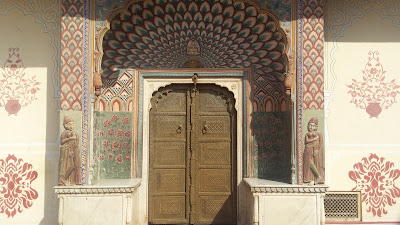
To be totally honest, I was only interested in seeing Agra, because Taj Mahal, right? Gee, typical tourist feels... But going to India is no simple feat. From Kuala Lumpur, it takes almost 6 hours by plane to reach Delhi. Agra has its own airport but does not receive any international flights. You fly either to Delhi or Jaipur if you want to end up within the Golden Triangle. And so New Delhi was included in my itinerary by default, it being my entry point to India. Jaipur, on the other hand? How did it end up on the list?
I only allot two days for every city nowadays. This is a travel formula I discovered lately that freely allows me to go sightseeing and work at the same time without being a zombie. The trick is to manage your time well and make sure to be wise as far as scheduling is concerned so that they don’t coincide. This means just four days in the subcontinent. Almost 12 hours of flight time for four days of stay and the USD 50 (~PHP 2,350) visa fee? And so I decided to include Rajasthan anyway. I’m glad I did, because it didn’t disappoint.

Just like Delhi and Agra, Jaipur has a minimum of three UNESCO World Heritage sites under its belt, which is a good number if you are planning to up your UNESCO been-there-done-that count. Rajasthan’s hill forts count as one, while Jantar Mantar is a separate attraction on the list. I forgot what the other one is because I didn’t visit it anymore. For this trip, I just limited the UNESCO goals to just two per city, and Day 1 was reserved for the Jantar Mantar and City Palace tandem which are right across each other.

Jantar Mantar is a park, sort of. But instead of flora and fauna, what you see are scientific tools utilized back then to predict various astronomical kind of shit such as planetary alignments and eclipse schedules. Of course, when we talk about ancient astrology or astronomy, what comes to mind are the Maya of Latin America. Well, whoever built these structures are clearly not Native Americans, but I think the idea was the same. The main difference is that the one in Jaipur seems purely scientific in nature, devoid of religion.

Yeah, whoever has visited some Mayan pyramids will quickly notice the religious aspects mainly concentrated on the intricate designs that serve as a tribute to local gods. At Jantar Mantar, what you see are staircases and the like that are really plain. They don’t have elaborate carvings meant to deify anyone or anything. They are just there, sticking like a sore thumb because a lot of people have no idea what the heck they are and what purpose they serve. And they look strange to boot!

This does not mean to say that you won’t get to appreciate the park. I mean, camwhores are happy anywhere as long as they can strike a pose in front of something exotic or plain weird. Let me remind you, though, that climbing the steps are not allowed. It would be cool to snap a selfie on top of one of those things but it’s prohibited. I don’t remember seeing benches inside but there are platforms where you can rest in case you feel a bit exhausted, what with the stark sun of this cruel Indian summer.

The entrance fee was INR 200 (~PHP 150), which is standard for foreigners. Students from foreign universities are said to get a 50% discount but I didn’t try it despite having my ID in my wallet. Anyway, right across the street is the City Palace which has more jaw-dropping photo-ops thanks to its opulence, something Jantar Mantar seems to lack. Hey, it’s a palace. Royalty needs to be pampered. Scientists, on the other hand, just need their tools to be happy.

You need to pay INR 500 (~PHP 375) to get in. The palace compound is not that huge, at least the area that tourists can explore. First stop is the textile museum which is included in the admission fee you just paid. Textiles are not everyone’s cup of tea so this one is hit or miss. What you see inside are obviously limited to displays of various royal outfits, carpets, and the like. Unless you have a really specific fascination for that, I don’t think you will enjoy the place. That’s fine, because it’s really small anyway. 10 minutes tops!

Go to the other side of the compound to check out the souvenir shop. Hooray, capitalism! I went back out at once when I came in because I am not a big fan of souvenir shopping. You’ll find many foreigners inside trying to find the perfect giveaway for loved ones back home. Sorry, but that’s just not my MO. You should feel my mother’s pain whenever she asks me to bring her back a souvenir plate with the name of the place engraved on it, and I be, like, WHAT ABOUT NO, Mom? Yup, I’m such a bad spawn.

Now it’s time to head to the entrance to the east. West? Sorry. I suck at directions. But believe me when I tell you that you’ll easily find that entrance. It leads to a small square with some sort of cultural demo in the middle. I never really found out what that was all about. Because the square is enclosed and has benches, this is the perfect place to find some shaded area where you can just sit down and relax.

There is a café and a restaurant. To the west of the gate you just entered is the entrance leading to the palace itself, which I believe now serves as a local government office. So yeah, it’s out of bounds, Tourist. To the east is a gallery dedicated to the history of Rajasthan’s monarchy as well as their connections to the British royalty during that time. Photography is not allowed inside so you have no other choice but feign admiration for the luxurious lives of Jaipur’s powers-that-be.

The Hawa Mahal is just down the street from the City Palace’s entrance. I told myself I’d just come back for it the next day after my trip to the Hill Forts. I never did. Why am I not surprised?
[JAIPUR] Ancient Astronomy Is Cool





_poster.jpg)



0 creature(s) gave a damn:
Post a Comment